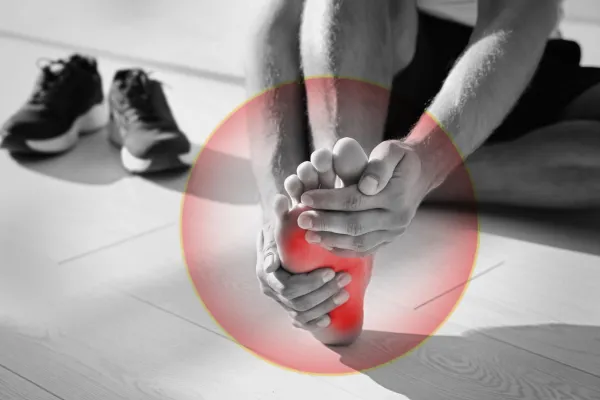
Is Your Foot Pain Caused by Poorly Fitting Shoes? Here’s How to Tell
Foot pain can disrupt your day-to-day life and affect your overall health. From mild discomfort to severe pain, foot problems can hinder mobility and make even simple tasks feel difficult. One common culprit for foot pain, which is often overlooked, is poorly fitting shoes. If you’ve been struggling with persistent foot pain, your shoes might be the issue. At The Springfield Clinic in Bishopbriggs, we see many patients who are unaware that their footwear is causing or worsening their foot pain. In this post, we’ll explore how poorly fitting shoes can lead to foot pain, and how you can tell if your shoes are to blame.
Understanding the Importance of Proper Footwear
Shoes are not just a fashion statement—they play a crucial role in supporting and protecting your feet. When shoes don’t fit properly, they can lead to a range of foot problems, from blisters and calluses to more serious conditions like bunions, heel pain, or plantar fasciitis. Poorly fitting shoes can cause pressure, friction, and misalignment, which over time, can damage the foot’s structure and affect your gait (how you walk).
How Poorly Fitting Shoes Cause Foot Pain
Shoes that don’t fit correctly can cause a variety of issues depending on how they’re misaligned with the natural structure of your feet. Here are some common ways shoes can contribute to foot pain:
1. Too Tight or Too Loose
When shoes are too tight, they pinch your toes and cause discomfort. This can lead to conditions like bunions, corns, or hammer toes, where the toes become deformed or misaligned. On the other hand, shoes that are too loose can cause your feet to slide around inside, leading to friction and blisters.
2. Lack of Arch Support
Shoes that don’t offer enough arch support can place strain on the bottom of your feet, leading to conditions like plantar fasciitis, where the ligament that supports the arch becomes inflamed. Without adequate support, the foot’s natural biomechanics can be altered, leading to discomfort and pain in the arch, heel, and even up the legs.
3. Flat Soles or High Heels
Shoes with flat soles or high heels can put excessive pressure on certain areas of your feet. High heels, for example, shift your weight forward, putting extra pressure on the toes and the ball of the foot. This can lead to conditions like metatarsalgia (pain in the ball of the foot) and increase the risk of foot injuries. Conversely, shoes with flat soles lack the necessary cushioning to absorb shock, which can contribute to joint pain and fatigue in the feet.
4. Narrow Toe Box
Shoes with a narrow toe box squeeze the toes together, causing misalignment and pinching. This can lead to painful conditions like bunions, blisters, and calluses. Over time, constant pressure on the toes can also result in permanent deformities, making it difficult to wear shoes comfortably.
Signs That Poorly Fitting Shoes Are the Culprit
Now that we’ve established how ill-fitting shoes can cause foot pain, let’s explore how you can tell if your shoes are the problem. If you’ve been experiencing any of the following symptoms, your shoes may be to blame:
1. Persistent Blisters or Calluses
If you regularly develop blisters or calluses, especially on your toes or heels, it’s a sign that your shoes are rubbing against your feet. This friction can cause skin irritation, leading to painful blisters and thickened skin (calluses).
2. Pain in the Toes or Balls of the Feet
Shoes that are too tight, have a narrow toe box, or don’t offer enough cushioning can cause pain in the toes or the balls of the feet. If you notice sharp or dull pain in these areas, it could be due to pressure from poorly fitting shoes. This discomfort may worsen with prolonged walking or standing.
3. Arch or Heel Pain
If your shoes don’t provide proper arch support or cushioning, you may experience pain in the arches or heels. Heel pain, especially when you first get out of bed in the morning, is a common symptom of plantar fasciitis, a condition that’s often caused or aggravated by inadequate footwear.
4. Foot Fatigue
If your feet feel tired or sore after walking short distances, it might be a sign that your shoes aren’t providing enough support. Ill-fitting shoes can make your foot muscles work harder than they should, leading to fatigue and discomfort.
5. Toe Deformities
If you notice changes in the shape of your toes, such as bunions, hammertoes, or crooked toes, it could be the result of wearing shoes that are too tight or too narrow. These deformities are caused by the constant pressure placed on the toes, leading to misalignment.
How to Choose the Right Shoes for Your Feet
Choosing the right shoes can be a game-changer when it comes to foot health. Here are some tips for ensuring your shoes provide the proper support and fit:
Get Properly Measured: Have your feet measured regularly, as foot size can change over time. Make sure your shoes fit both the length and width of your feet.
Choose Shoes with Adequate Arch Support: Look for shoes that provide the right amount of support for your foot type. If you have flat feet or high arches, consider custom orthotics to provide extra support.
Look for Cushioning: Shoes with cushioning in the sole can help absorb shock and reduce pressure on your feet, particularly if you walk or stand for long periods.
Avoid Narrow Toe Boxes: Make sure your shoes have enough room in the toe box to allow your toes to move freely. Shoes should feel snug, but not tight.
What to Do If You Have Foot Pain
If you’re experiencing foot pain, it’s essential to consult with a professional podiatrist. At The Springfield Clinic in Bishopbriggs, we specialize in diagnosing and treating foot pain caused by poorly fitting shoes and other factors. Our team can assess your feet, provide recommendations on appropriate footwear, and offer treatment options to alleviate pain and prevent further damage.
Conclusion
Poorly fitting shoes can lead to a variety of painful foot conditions, from blisters and calluses to more serious problems like plantar fasciitis and toe deformities. If you’re experiencing persistent foot pain, it’s essential to evaluate your footwear. Make sure your shoes fit properly, offer adequate support, and allow room for your feet to move naturally. If foot pain persists, don’t hesitate to seek help from a professional podiatrist. At The Springfield Clinic in Bishopbriggs, we’re here to provide expert care and guidance to help you walk comfortably and pain-free.



